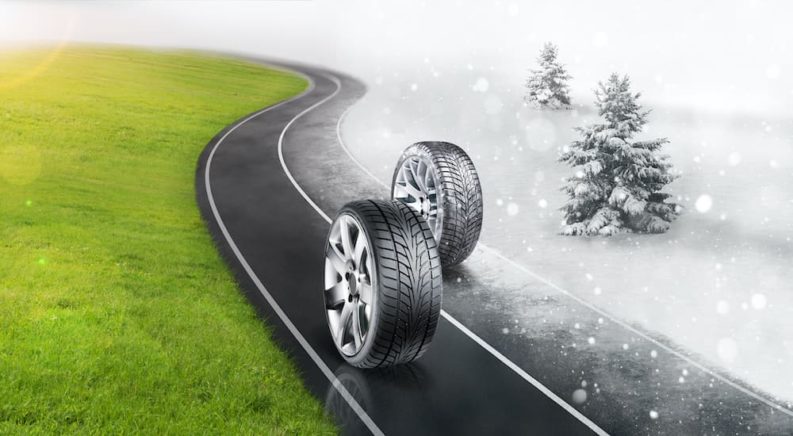Tires are one of the most crucial parts of any vehicle on the road – after all, a car isn’t a car without wheels. It’s important to make sure that your tires are of extremely good quality, and, while we would like to assume that every tire is the same, that couldn’t be farther from the truth. Just like most other things, every tire is unique and suited to a different type of driving. So, before paying a visit to a tire shop near you, make sure to read up on what different types of seasonal tires can offer for your driving experience.
Road conditions naturally vary from season to season. In winter, you have snow and ice to contend with, while a drive in summer is going to deal with high temperatures and possibly heavy rain. Of course, for both comfort and safety sake, tire manufacturers make many different types of tires tailored to each season.
What Makes a Tire?
You may not think very much of tires, but the average tire is the result of hard work and over a century of development. A tire is more than just a piece of rubber coating a wheel – every part is specifically designed for a specific purpose. A tire can be separated into two distinct parts: the tread that makes contact with the ground, and the body which gives the tread support. Without the tread, the car wouldn’t be moving, and without the body, the tire would fall apart.
Seasonal tires modify these parts to deliver specialized performance that is meant to be used during certain portions of the year. By changing the tread design, a wheel can be better prepared for the snow and ice found during winter in many parts of the United States. On the other hand, a better-designed body can provide for a more comfortable experience, as well as higher reliability in a range of temperature conditions. Although the extent of the changes will depend on the type of tire in question, it is changes like these that make a seasonal tire.

All-Season Tires
The all-season tire type is more common in smaller passenger vehicles, like sedans and minivans. These tires are more common than other specialized tires, giving generally good performance year-round. They offer a well-rounded tread pattern, giving good overall handling in wet conditions or mild winter weather. This makes all-season tires an ideal choice for those living in areas with small changes in season and high amounts of rain.
Winter Tires
Winter tires are one variant that is very common in a wide variety of different vehicle types. The rubber in a winter tire is designed to handle very cold conditions, ranging well below 45 degrees. With very deep grooves in the treads, the tire is designed to remove snow very well. This provides the traction needed to prevent low friction events, like fishtailing, making for an overall safer drive than with normal tires.
Summer Tires
Summer tires are similar in design to all-season tires. Available primarily on small-passenger vehicles, like all-season tires, summer tires are designed for good performance in both wet and dry conditions. However, summer tires are not designed to be used all-year-round, more suited to hotter conditions. With solid contact on the tread, summer tires are excellent at creating higher friction in wet conditions, offering greater overall resistances against hydroplaning. However, they perform extremely poorly on snow or ice.
Why Buy Seasonal Tires?
You may be asking yourself if you should even bother changing your tires each season. While choosing all-season tires is a valid option, there are a lot of reasons to choose a rotation of tires over a year-round system. For one, while all-season tires offer good overall performance, they don’t excel in any one condition. As such, all-season tires may have trouble in more extreme climates; for example, in snow where winter tires could drive with ease, all-season tires may not be able to offer the same performance.

How to Buy Tires?
While it may be tempting to just waltz into the nearest tire shop now that you know which tires you need, it’s not quite that time yet. There are certain things that you need to know before you can buy your new tires. Like car batteries, there are certain things you need to keep in mind when buying tires specifically for your car. Not all cars are the same, and so tires also vary in size and mounting type.
What are Tire Codes?
If you look on the sidewall of any tire, you will notice a mishmash of letters and numbers. This is called a tire code, and it will tell you everything you need to know about a tire: width, load index, diameter, etc. For example, a tire code may look something like this:
P200/60R13 90H M+S
In these cases, the tire code is rather simple to read and understand. P represents the type of car the tire is designed for – in this case, a passenger vehicle. The rest of the code is far more important:
- 200 is the width of the tire in millimeters.
- 60 is the sidewall height as a percentage of the tire width.
- 13 is the rim’s diameter in inches
- 90 is the load index
- M+S signifies “mud and snow” capabilities.
You should make sure that all of these numbers fit your vehicle’s specifications, which can commonly be found inside the front door frame or in your owner’s manual.
Where and Which Tires Should I Buy?
Tires themselves can be found in a large number of retailers. Even Walmart has an automotive section of many of its shopping centers that offers tires and auto parts and many other repairs and services. However, for the best quality tires, it may be a good idea to go to a store that specializes in automotive repairs and tires. Many dealerships also offer tires for the cars they sell. That said, there are even shops that sell tires as their main product, and these types of retailers will often have the biggest variety of seasonal tires.
When looking to buy a seasonal set of tires, the task can seem daunting at first. Like most automotive parts, tires have a plethora of different brands that are going to say they are the best tire. In reality, each of these brands has a different balance of quality to affordability, and it’s really up to your personal preference which brand you choose. Granted, almost any brand is going to get the job done, but if you’re looking for a tire that will last a long time, then Michelin, Bridgestone, and Goodyear are the three largest manufacturers and offer a wide array of high-quality tires.
In the end, while the brand doesn’t matter, buying quality tires for each season can be important for your overall comfort behind the wheel. Buying seasonal tires will not only enhance your car’s performance, but they will also make for a safer and more relaxing drive no matter the conditions. There is no better reason to visit a tire shop near you.

